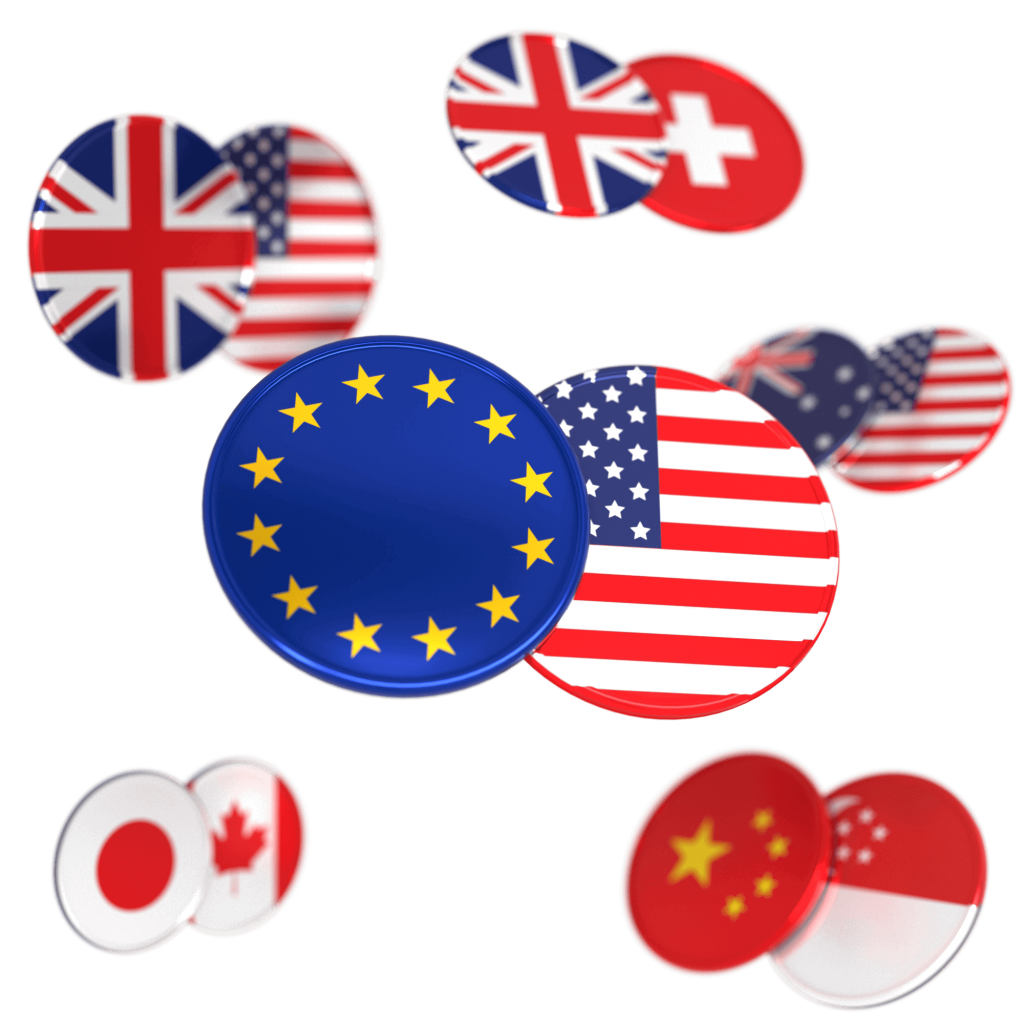Forex
Trade CFDs on 55+ currency pairs – majors, crosses and exotics. Tight spreads and NO re-quotes
Use our advanced trading tools to secure profits and limit losses.
Why trade Forex currencies with ALS Markets?

Lowest spreads
The spreads on the forex currency pairs are considered the lowest from all trading instruments.

Highest Volatility
The forex currencies and the forex market itself is the most volatile amongst all asset classes.

Big leverage
When it comes to forex trading, the leverage is the biggest (1:500) for major currency pairs.

Trusted broker
All of the advantages of trading currencies doesn’t make sense if you trade with the wrong broker. Choose a trusted broker like us.
Forex Currencies
Trade major, minor and exotic currency pairs
Foreign Exchange market (FOREX or FX) is the world’s largest decentralized financial market, with trading volumes exceeding 7 trillion US dollars a day. It’s a bigger market than most of the biggest stock markets combined and it’s the most volatile one.
Trading 24-hours a day and 5 days a week, there’s always an opportunity to buy or sell volatile currencies.

Understanding Foreign Exchange:
Foreign exchange, commonly referred to as Forex or FX, involves the buying and selling of currencies with the aim of profiting from their value fluctuations. As the world’s largest financial market, the forex market surpasses the stock market in size, offering unmatched liquidity. This high liquidity attracts a wide array of traders, from beginners to seasoned professionals.
Our Trading Approach:
At ALS Markets, we operate as a pure STP (straight-through processing) broker and exchange. This means we do not and cannot trade against you. Leveraging our ECN and P2P liquidity, we ensure the best pricing options available in the market, providing our clients with optimal trading conditions.
The Forex Market Landscape:
The forex market is a dynamic global arena with approximately $4 trillion USD traded daily, making it the most liquid market worldwide. This liquidity allows traders to buy large volumes of almost any currency while the market is open. Operating 24 hours a day, five days a week from Monday to Friday, the forex trading day begins with the opening of markets in Australia, moves through Asia and Europe, and concludes with the USA markets before closing.
During the summer months, the forex market opens at 9:00pm GMT on Sunday and closes at 9:00pm GMT on Friday. In winter, trading hours shift to 10:00pm GMT for both opening and closing times. Because of its continuous trading cycle, forex offers opportunities at all hours, ensuring that traders can execute positions without being left with untradeable assets, unlike other financial instruments.
Whether you are new or experienced, trading forex offers an unparalleled chance to participate in the global financial markets, backed by our commitment to transparent and reliable exchange services.
Currency Pairs

In the world of foreign exchange (forex), hundreds of global currencies are each identified by unique three-letter symbols. For instance, the American Dollar is represented as USD, the Euro as EUR, the Swiss Franc as CHF, and the British Pound as GBP. These symbols form the building blocks of the forex market.
Types of Currencies: Major vs. Minor
Currencies are broadly categorized into major and minor currencies. Major currencies stem from the world’s leading economies, including the USA, Japan, UK, the Euro Zone, Canada, Australia, Switzerland, and New Zealand. These strong currencies are paired with others to create forex pairs.
Trading Forex: An Exchange of Value
Similar to how we exchange money for goods like milk at a store, forex trading involves buying or selling one currency in exchange for another. In forex pairs, currencies are valued and traded against one another.
Types of Forex Pairs: Major, Minor, and Exotic
Forex pairs are classified into three main types: Major pairs, Minor pairs, and Exotic pairs. Major pairs always include the USD and are the most actively traded. The seven major pairs are EUR/USD, USD/JPY, GBP/USD, USD/CAD, USD/CHF, AUD/USD, and NZD/USD. Minor pairs involve trading major currencies against each other, excluding the USD, such as EUR/GBP or GBP/JPY. Exotic pairs consist of one major currency and one from a smaller economy, like EUR/TRY or USD/NOK.
Most Popular FX Pairs
Forex Terminology
Bid & Ask : The most traded currency pair is the Euro against the American Dollar, known as EUR/USD. In this pair, the Euro is the base currency, which you buy or sell, while the USD is the secondary currency used for the transaction. Each currency pair has two prices: the “ask,” which is the selling price of the base currency, and the “bid,” which is the buying price. The difference between these two prices is called the spread, which represents the broker’s fee for opening a position. High liquidity in a currency often leads to tighter spreads, while lower liquidity, with its increased volatility, leads to wider spreads.
Forex Quotes and PIPs : Forex quotes typically display four decimal places, such as 1.2356. For the EUR/USD pair, this means 1.2356 US dollars per Euro. The smallest change in the currency value is known as a PIP, usually affecting the fourth decimal place. Gains, losses, and spreads are typically measured in PIPs.
Trading Terminology – Long & Short : In forex trading, “going long” means buying a currency, and “going short” means selling a currency. These terms are fundamental for trading strategies.
Market Trends – Bullish & Bearish : Traders expecting market rises are termed as “Bullish Traders,” while those anticipating a downward trend are “Bearish Traders.” A “Bull Market” signifies rising trends, whereas a “Bear Market” indicates falling trends. Experienced traders align their strategies accordingly, staying informed on market trends to capitalize on movements.
The Role of Trading Platforms : Traditional trading involved calling brokers for transactions. Today’s trades are executed directly by the trader via trading platforms. Finding the right platform is crucial, allowing traders to implement their strategies effectively and comfortably.
Liquidity Providers & Their Impact : Liquidity providers, including top banks and financial institutions, offer price quotes that help reduce the bid-ask spread and commissions. High liquidity ensures instant order execution at desired prices without delays.
The Role of a Liquidity Bridge : We utilize a liquidity bridge to aggregate pricing data from multiple LPs, connecting them seamlessly with ALS Markets’ MT5 trading platform. This bridge enables us to offer True ECN pricing to our clients through our extensive LP network.
Leverage in Trading : Leverage, provided by brokers, allows traders to hold larger trading positions than their actual capital would permit. While leverage can enhance profits, it also increases potential losses. Therefore, employing proper risk management techniques is crucial when using leverage.
Understanding these concepts is vital for navigating the forex market effectively and formulating sound trading strategies.
Factors Influencing the Forex Market
The forex market boasts exceptional liquidity, driven by high supply and demand dynamics. Traders engage in transactions based on both financial and general events. An increase in demand for a particular currency naturally enhances its value relative to others, and vice versa.
Impact of Financial Events
Financial events, such as official announcements from countries, central banks, or financial institutions, play a significant role in the forex market. These events include data releases on unemployment rates, manufacturing outputs, and more. For example, a drop in a country’s unemployment rate may signal economic strength, potentially increasing the value of its currency. Major financial announcements can have a ripple effect, influencing multiple currencies. Traders often speculate on these events before they occur, using insights to inform their trading strategies. An economic calendar is an essential tool for tracking these impactful events.
Example: Trading the EUR/USD Pair
Consider the popular trading pair EUR/USD. When a trader logs into the platform, they examine the ask and bid prices—let’s say 1.2356 (ask) and 1.2359 (bid). The 3-pip difference represents the broker’s fee. If a trader anticipates a rise in the Euro, they may execute a ‘buy’ command for 10,000 units, costing $12,356. With leverage, the required margin could be as low as $30.89. Should the market move as anticipated, with the Euro increasing from 1.2356 to 1.2360—an improvement of 4 pips—the trader would realize a profit.
Understanding these factors and how they impact trading decisions is crucial for success in the forex market. By leveraging timely information and strategic insights, traders can make informed choices and maximize their trading potential.
Trade Forex with ALS Markets
- Tight spreads starting from 0.0 pips
- 24/5 trading availability
- Wide range of 40+ currency pairs
- No minimum deposit requirement
- Quick and efficient deposits & withdrawals

Three types of accounts, catering to every trader, whether you are a beginner or experienced.
Nano Account
$100/ Min Deposit
Ideal for new and intermediate traders
- Leverage up to 1:400
- Spread starting from 1.6 pips
- MT5 with EAs & 80+ technical tools
- ECN tech with Tier liquidity
- Access to advanced educational tools
- No Dealing Desk intervention
Standard Account
$1000/ Min Deposit
Tailored for experienced traders
- Leverage up to 1:400
- Spread starting from 0.5 pips
- MT5 with EAs & 80+ technical tools
- ECN tech with Tier liquidity
- Access to advanced educational tools
- No Dealing Desk intervention
Pro Account
$25000/ Min Deposit
Suited for Seasoned Traders & investors
- Leverage up to 1:200
- Spread starting from 0.3 pips
- MT5 with EAs & 80+ technical tools
- ECN tech with Tier liquidity
- Access to advanced educational tools
- No Dealing Desk intervention
